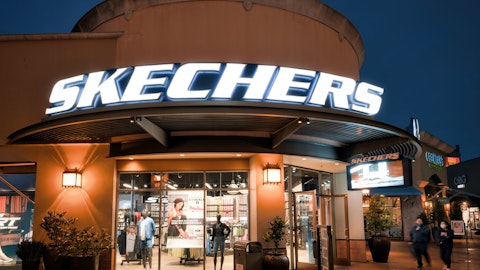But overall, I’d say the net effect of it was definitely results that exceeded our expectations.
John Kernan: That’s very helpful. Thanks. And then I guess with the $3.25 to $3.40 EPS guidance, maybe talk to some of the puts and takes within gross margin and also the balance between demand creation and marketing expenses to keep the top line moving at this pace.
John Vandemore: Yes. I would say from the balance of the year, I think the one thing to note is we’re getting to a point where we’re going to start comping against some stronger results last year. If you remember last year, kind of the curvature, if you will, of gross margin was that the first half of the year was bad. The back half of the year got better. So some of that — the comparability simply won’t be as favorable because last year wasn’t as detrimental. Clearly, we still have we think benefits coming from a cost perspective. We’ve now fully annualized pricing though. So that will offset. The net effect of it is, again, we feel like we’re in a good resting spot going forward with kind of that improvement in each quarter relative to the prior year.
The one thing to keep an eye on is mix. We did obviously tilt favorably toward mix. We could see growth in our wholesale business, which would again be potentially detrimental to gross margin, but more gross profit dollars, and we’ll take that because that leads to more earnings for our shareholders. And that’s obviously our ultimate objective. So there’s always — we’re still not fully clear of COVID, there’s a lot of noise. But I would just say that the comparability going forward becomes more normal and that will just make the delta a little bit smaller as a result of being compared against a prior year that started to get better. The one thing I would note, though, is we are optimistic about back-to-school. We’re optimistic about the holiday period.
We are currently in a position where if you recall last year, we had a lot of on-hand inventory, and we had to deal with that. And obviously, we’re much trimmer today than we were at the end of the year. We’re down nearly $300 million of inventory versus just December, which gives you a sense of how much we focused on that issue and resolved it. But we also had last year not a lot of depth in stores, and that’s been resolved so that our stores are generally in stock with the right products. So we do think that is a little bit of a continuing tailwind, particularly in the third quarter and into the early part of the fourth.
John Kernan: That’s great. Congrats on all the success. Thank you.
John Vandemore: Thanks, John.
Operator: Next question comes from Tom Nikic with Wedbush Securities. Please go ahead.
Tom Nikic: Hi, guys. Thanks for taking my question. I wanted to follow up on domestic wholesale. How do inventory levels look for your brand at the U.S. wholesale channel? And have you gotten any sense that some of the overhangs of inventory for some of the other brands out there have started to alleviate? Thanks.
John Vandemore: Yes. I would say when we look into inventories at kind of our top 10, top 20 wholesale customers in domestic markets, inventories looked pretty good. In fact, I would argue probably a little bit leaner than we want them to be. And so we think that tees up well for strong sell-through driven reorders. Now again, they’re dealing with inventory issues that extended beyond the Skechers brand and that, we believe, has been one of the bigger challenges. Although I would just note, it’s not every customer. We have wholesale customers out there who are doing fantastic. And that’s what led to some of the improvement in results relative to our second quarter. So, look, I don’t know how long it will take them to deal with the totality of whatever congestion they’re experiencing.
What we do know is that our product is in demand and selling well. There certainly doesn’t appear to be any significant backup to our inventories in those key accounts. And so we think that — and pricing is good. The factors tee up well for an acceleration of reorders once they’re clear of whatever challenges they’re experiencing.




